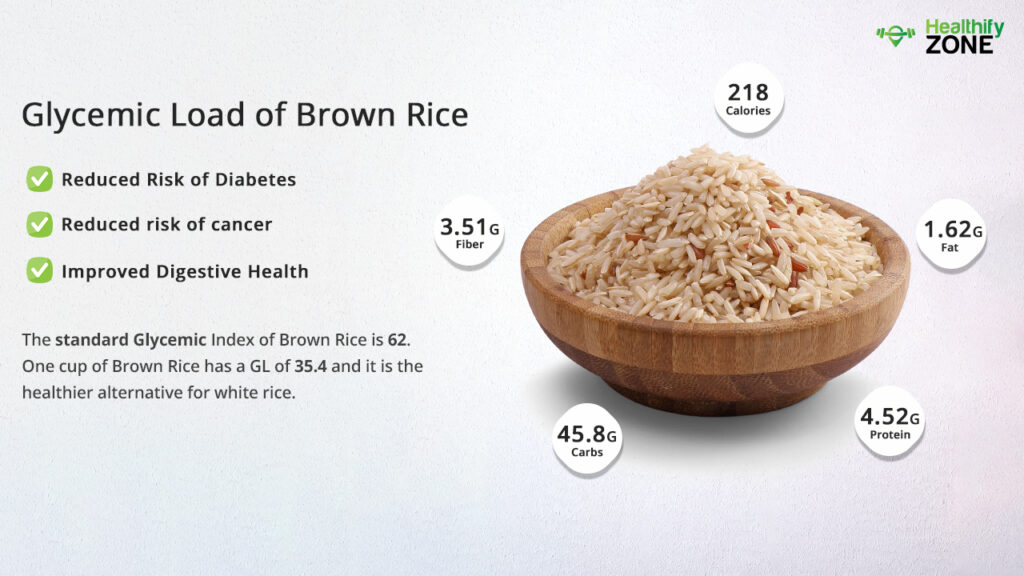The measure of the carbohydrate content in food and the pace at which it increases the blood glucose levels is called the Glycemic Load. A simple way of making a healthier choice is following the Glycemic Index. It is helpful and makes a comparison to find alternative sources of nutrients according to the blood glucose levels. Glucose has a higher blood glucose response in comparison with fructose.
Brown rice is generally associated with healthy eating because it is a whole grain, and hence, better than white rice, which has had its hull, brand, and germ removed. Brown rice only has its hull removed and has its bran and germ intact. Essentially, brown rice has all nutrients like vitamins, minerals, and antioxidants. According to the International Glycemic Index Tables, the GI of Brown Rice is 62. However, people are avoiding brown rice because of the rise of low-carb diets.

Brown rice comprises healthy nutrients like
- Fiber
- Protein
- Thiamine
- Niacin
- Pyridoxine
- Pantothenic Acid
- Iron
- Magnesium
- Phosphorous
- Zinc
- Copper
- Manganese
- Selenium
How to Calculate Glycemic Load of Brown Rice?
The standard Glycemic index of brown rice is 68. The high glycemic index of the foods helps in reducing the risks related to cardiovascular diseases. If we want to talk about diet, the key to prevent diabetes or any chronic illness is to distribute the carbohydrate consumption content throughout the day and manage the sugar levels in the body correctly— although a better alternative of white rice; it is not suggested to be taken in large portions. You can have rice once in a while just before hitting the gym or after.
The Formula/Procedure For Calculation of Glycemic Index of the Watermelon :
GL = GI * carbs / 100
where
- GL – glycemic load;
- GI – glycemic index;
- and carbs – the amount of carbohydrates in the portion.
| SL.NO | BROWN RICE BY WEIGHT IN (g) | GLYCEMIC LOAD |
| 1. | 100 g of Brown Rice | 15.6 (medium) |
| 2. | 250 g of Brown Rice | 39 (high) |
| 3. | 500 g of Brown Rice | 78 (high) |
| 4. | 1 Kg of Watermelon | 58 (very high) |
| 5. | 1 Cup of Brown Rice Flour (165 g) | 77 (very high) |
| 6. | 1 Cup of Brown Rice | 35.4 (high) |
Is Brown Rice Safe to Consume If You Have Diabetes?
For people with diabetes, it is important to reduce carb intake and choose healthier options to control blood sugar. Given that carbohydrates have the highest impact on blood sugar, diabetic people can reduce blood sugar and insulin spikes by having fewer refined grains like white rice. If you replace white rice with brown rice, you will benefit a lot. Brown rice has a lower GI than white rice. Hence, it has a lesser impact on blood sugar and is digested slower. You must have brown rice as a replacement for refined grains, which can help you control your blood sugar level and reduce the chances of developing diabetes.
Can I Eat Brown Rice During a Fat-Loss Diet?
If you replace refined grains with brown rice, it will help you in the fat-loss diet. Studies show that people who consume whole grains weigh lesser than those who ate lesser whole grains.

- A 100g serving of brown rice has a GL of 15.6 which is in the permissible levels.
- Anything more than 200g of brown rice is something which shoud be taken rarely if you are on a fat-loss diet.
Can I Eat Brown Rice During a Low-Carbohydrate Diet?
You can eat brown rice during a strict low-carb diet. However, the portion size of what you consume is something you should be careful about. We suggest you not eat more than 100 g of brown rice in one serving.
Is Brown Rice High in Sugar?
100 g of brown rice has 23 g of carbs and 0.4 g of sugar. It is very low in sugar and highly nutritious. You can incorporate it into your regular diet.